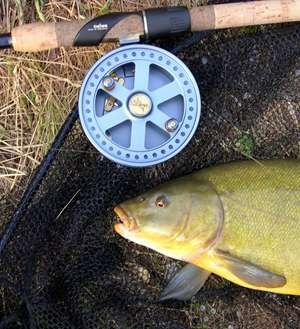| MARK WINTLE |
| Mark Wintle, an angler for thirty-five years, is on a quest to discover and bring to you the magic of fishing. Previously heavily involved with match fishing he now fishes for the sheer fun of it. With an open and enquiring mind, each week Mark will bring to you articles on fishing different rivers, different methods and what makes rivers, and occasionally stillwaters, tick. Add to this a mixed bag of articles on catching big fish; tackle design, angling politics and a few surprises. Are you stuck in a rut fishing the same swim every week? Do you dare to try something different and see a whole new world of angling open up? Yes? Then read Mark Wintle’s regular column. |
| EATING MY HAT – CENTREPINS I must confess that I’ve never been a great fan of centrepin reels. I could understand their simplicity, and even their beauty, but not their effectiveness. I guess this stems from the amount of match fishing that I used to do. Despite the claims of the wonderful presentation to be obtained trotting with a centrepin, I always reckoned that I could do as well, but faster, with a good fixed spool reel.Now my match fishing days are all but over I can indulge myself, and recent experiences of a style of fishing far removed from trotting have finally convinced me of the true merits of using a centrepin. I am, to coin a phrase, going to eat my hat!
Now, having had the pleasure of watching many brilliant anglers fish with a ‘pin, I’ve long recognised that in the right hands using one can be deadly, but the real challenge is recognising where using one is truly advantageous rather than a handicap. Those that I’ve had the pleasure of watching include Dave Thomas winning a World Championship, Wayne Swinscoe on the Trent in a National, Billy Lane, John Searl, Bill Rushmer, Cliff Howard, Andy Nellist, Johnny Clayton of CAC, Chris Yates and John Wilson (only on TV, alas), plus many locals and visitors on my local waters. There are some who adapt their entire style of fishing around using a centrepin, and I would include John Searl in this category. The guy is like a heron. Still, quiet, and deadly. No long casts, just stealth and precision. Bill Rushmer is another master of the precise, close-in style. Both these anglers have concentrated on this style for many years but its simplicity makes it relatively easy to learn. Stealth is part of the key; accurate plumbing, feeding and tackle control complete the picture. And it is in this type of fishing that I am going to give fishing with a ‘pin a thorough trial. My local gravel pits around Ringwood lend themselves to many styles of fishing: pole fishing, feeder or method fishing, standard carp rigs, waggler and slider fishing, and one that is, during the summer and autumn, often the deadliest of all – close in float fishing. Sitting well back from the bank, and keeping disturbance to a minimum, it is possible to float fish just a few feet out and catch big fish. The close control means good presentation and bite detection. Feeding is precise. Float choice can be a simple short piece of peacock quill, or, better in my opinion, a pole float taking about 0.5 to 1.0 gram with a thickish bristle.
On these pits one can expect good crucians (to 3lbs), roach (over a pound), tench (to 7lbs) and carp (to 20lbs) to be caught with this style. Effective baits include old favourites like bread, casters and sweetcorn, as well as the ubiquitous and deadly pellets. Over the years, many anglers have become masters of this style on these waters, and a standard tackle has evolved. Broadly speaking, most use what would be termed power match rods or Avon type rods, with a few using long rods of 17 – 20 feet. These are the sort of rods that are well matched to 4 – 6lbs bs line. There are too many decent sized carp (mostly 6 – 14lbs) and tench to fish any lighter than this during the summer. Mostly the waters are snag free so there is little hook and hold type fishing. When using tackle of this nature the hook needs to match the strength of the rod and line being used. I have used Kamasan B711 in 13 and 11, and Drennan Super Specialist in 12 and 10, matched to 5 and 6lbs Daiwa Matchwinner hook lengths, with a mainline of Daiwa Sensor 6lbs. This started as being about reels so let’s return there. When I started to employ this method a lot two years ago (I’ve always fished this method but not on a regular basis), I used Shimano Stradics in small sizes. With faultless clutches, they proved excellent for the job. But remember there is no casting involved in this method. The float is literally fished under the rod top. What I found was happening was that I got plenty of silly tangles where the line was slack or the reel was tending to backwind. Three years ago I acquired several centrepin reels. What has become clear is that different centrepin reels are more suited than others for different tasks. I have a beautiful Adcock Stanton that must be perfect for trotting, ditto an original Dave Swallow reel. For this close-in fishing a more robust reel is required. An old Rapidex is the tool of choice for many, but the one I’ve been trying has been a modern Arnold Kingpin, made in nearby Ferndown. This reel is strongly made and ideal for using 4 – 6lbs line. Be aware that some old ‘pins were made with soft pins that the line is wound on, and that loading 8lbs line under heavy tension can bend the pins making the reel unusable. I’ve seen this happen with the old Trentman ‘pins made around 1970. In use, the reel has been simplicity itself. I have been using a 17ft Daiwa rod, and therefore have to let off a little line to rebait, and then retrieve that line to get the float with two feet of the rod tip. It has been tangle free. The real revelation has been in playing fish. Previously I have only caught roach and dace with a ‘pin. This time around, I have been catching plenty of tench to five pounds plus carp to twelve pounds. The sheer winding power and ability to control the fishes’ runs under strong tension on the ‘pin has outperformed even the exceptional Stradic reels that I have grown to appreciate. So where do I go next? I shall have to look for more opportunities for this style of fishing. Certainly, down on the tidal Stour and Christchurch Harbour there are plenty of spots where some close-in fishing with bread can pay dividends for roach, bream and mullet. The Mullet Club maestros all use ‘pins on this water, and there is a very strong tradition of using ‘pins in this area. It will be a case of loading a ‘pin with lighter line, say 21/2 lbs for the roach, 4lbs for the mullet, choosing a swim carefully, and seeing how it goes. Next: ‘Stour Chub on Pellet’ |















